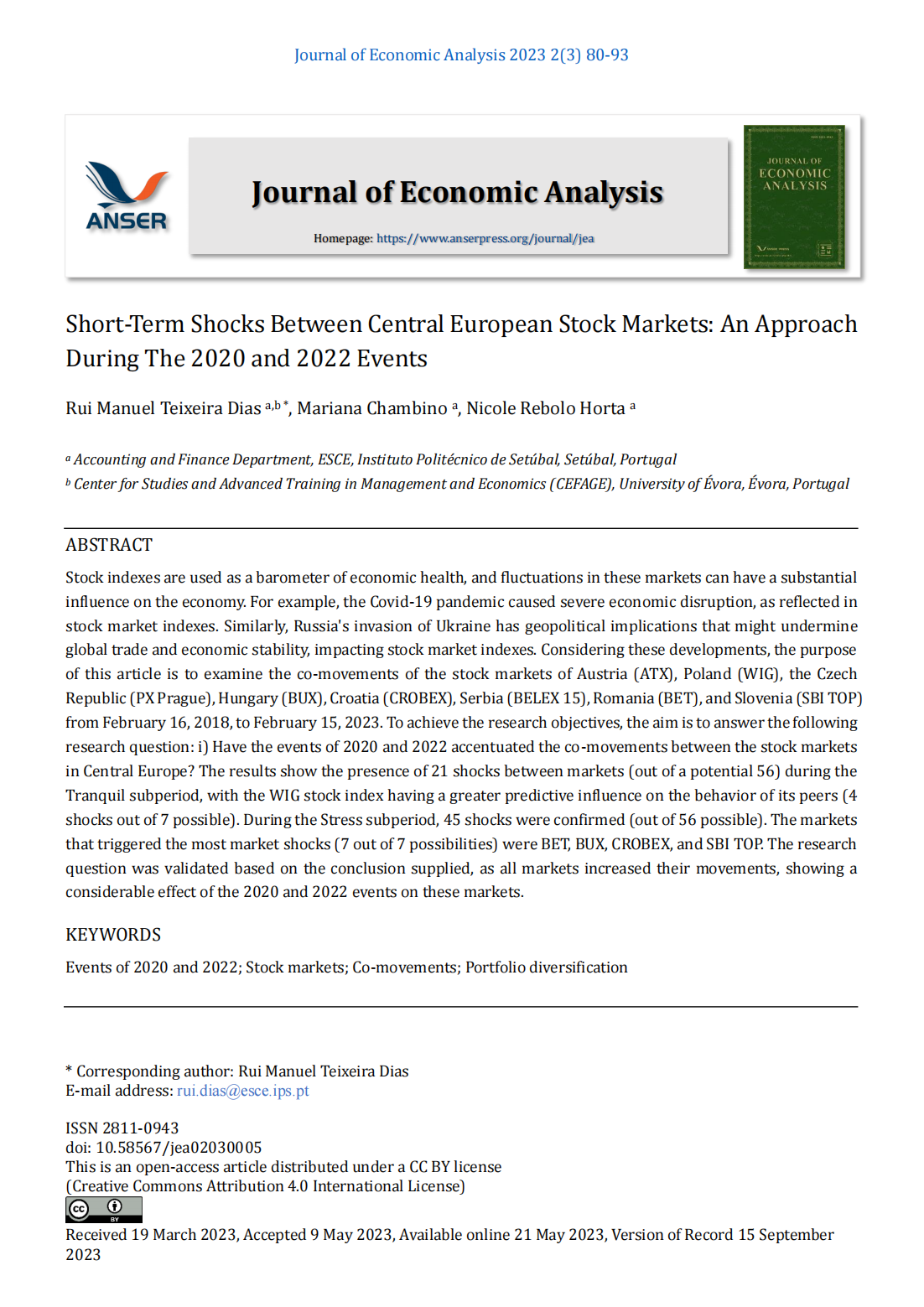Short-Term Shocks Between Central European Stock Markets: An Approach During The 2020 and 2022 Events
DOI:
https://doi.org/10.58567/jea02030005Keywords:
Events of 2020 and 2022, Stock markets, Co-movements, Portfolio diversificationAbstract
Stock indexes are used as a barometer of economic health, and fluctuations in these markets can have a substantial influence on the economy. For example, the Covid-19 pandemic caused severe economic disruption, as reflected in stock market indexes. Similarly, Russia's invasion of Ukraine has geopolitical implications that might undermine global trade and economic stability, impacting stock market indexes. Considering these developments, the purpose of this article is to examine the co-movements of the stock markets of Austria (ATX), Poland (WIG), the Czech Republic (PX Prague), Hungary (BUX), Croatia (CROBEX), Serbia (BELEX 15), Romania (BET), and Slovenia (SBI TOP) from February 16, 2018, to February 15, 2023. To achieve the research objectives, the aim is to answer the following research question: i) Have the events of 2020 and 2022 accentuated the co-movements between the stock markets in Central Europe? The results show the presence of 21 shocks between markets (out of a potential 56) during the Tranquil subperiod, with the WIG stock index having a greater predictive influence on the behavior of its peers (4 shocks out of 7 possible). During the Stress subperiod, 45 shocks were confirmed (out of 56 possible). The markets that triggered the most market shocks (7 out of 7 possibilities) were BET, BUX, CROBEX, and SBI TOP. The research question was validated based on the conclusion supplied, as all markets increased their movements, showing a considerable effect of the 2020 and 2022 events on these markets.
References
Breitung, J. (2000). The local power of some unit root tests for panel data. Advances in Econometrics, 15. https://doi.org/10.1016/S0731-9053(00)15006-6
Coeurdacier, N., & Guibaud, S. (2011). International portfolio diversification is better than you think. Journal of International Money and Finance. https://doi.org/10.1016/j.jimonfin.2010.10.003
Dias, R., & Carvalho, L. C. (2020). Hedges and safe havens: An examination of stocks, gold and silver in Latin America’s stock market. Revista de Administração Da UFSM, 13(5), 1114–1132. https://doi.org/10.5902/1983465961307
Dias, R., Alexandre, P., & Heliodoro, P. (2020a). Contagion in the LAC Financial Markets: The Impact of Stock Crises of 2008 and 2010. Littera Scripta, 13(1). https://doi.org/10.36708/littera_scripta2020/1/3
Dias, R., Alexandre, P., & Heliodoro, P. (2020b). Contagion in the LAC Financial Markets: The Impact of Stock Crises of 2008 and 2010. Littera Scripta, 13(1). https://doi.org/10.36708/littera_scripta2020/1/3
Dias, R., da Silva, J. V., & Dionísio, A. (2019). Financial markets of the LAC region: Does the crisis influence the financial integration? International Review of Financial Analysis, 63(March), 160–173. https://doi.org/10.1016/j.irfa.2019.02.008
Dias, R., Pardal, P., Teixeira, N., & Machová, V. (2020). Financial Market Integration of ASEAN-5 with China. Littera Scripta, 13(1). https://doi.org/10.36708/littera_scripta2020/1/4
Ferreira, P., Dionísio, A., & Movahed, S. M. S. (2017). Assessment of 48 Stock markets using adaptive multifractal approach. Physica A: Statistical Mechanics and Its Applications, 486, 730–750. https://doi.org/10.1016/j.physa.2017.05.046
Grabowski, W. (2019). Givers or Recipients? Co-movements between stock markets of CEE-3 and developed countries. Sustainability (Switzerland), 11(22). https://doi.org/10.3390/su11226495
Granger, C. W. J. (1969a). Investigating Causal Relations by Econometric Models and Cross-spectral Methods. Econometrica, 37(3), 424. https://doi.org/10.2307/1912791
Granger, C. W. J. (1969b). Investigating Causal Relations by Econometric Models and Cross-spectral Methods. Econometrica, 37(3), 424. https://doi.org/10.2307/1912791
Hadri, K. (2000). Testing for stationarity in heterogeneous panel data. The Econometrics Journal. https://doi.org/10.1111/1368-423x.00043
Harkmann, K. (2022). Integration of the Baltic stock markets with developed European markets. International Journal of Finance and Economics, 27(1). https://doi.org/10.1002/ijfe.2165
Hung, N. T. (2022). Return equicorrelation and dynamic spillovers between Central and Eastern European, and World*1stock markets, 2010–2019. Regional Statistics, 12(1). https://doi.org/10.15196/RS120108
Jarque, C. M., & Bera, A. K. (1980). Efficient tests for normality, homoscedasticity and serial independence of regression residuals. Economics Letters, 6(3). https://doi.org/10.1016/0165-1765(80)90024-5
Koseoglu, S. D., & Cevik, E. I. (2013). Testing for causality in mean and variance between the stock market and the foreign exchange market: An application to the major central and Eastern European Countries. Finance a Uver - Czech Journal of Economics and Finance, 63(1).
Lütkepohl, H. (1993). Testing for Causation Between Two Variables in Higher-Dimensional VAR Models (Vol. 114, Issue 4, pp. 75–91). https://doi.org/10.1007/978-3-642-51514-9_4
Markowitz, Harry. (1952). Portfolio Selection. The Journal of Finance, 7(1), 77. https://doi.org/10.2307/2975974
Pardal, P., Dias, R., Teixeira, N. & Horta, N. (2022). The Effects of Russia’ s 2022 Invasion of Ukraine on Global Markets: An Analysis of Particular Capital and Foreign Exchange Markets. https://doi.org/10.4018/978-1-6684-5666-8.ch014
Parzen, E. (1982). ARARMA models for time series analysis and forecasting. Journal of Forecasting, 1(1), 67–82. https://doi.org/10.1002/for.3980010108
Pietrzak, M. B., Fałdziński, M., Balcerzak, A. P., Meluzín, T., & Zinecker, M. (2017). Short-term shocks and long-term relationships of interdependencies among central european capital markets. Economics and Sociology, 10(1). https://doi.org/10.14254/2071-789X.2017/10-1/5
Sims, C. A. (1980). Macroeconomics and Reality. Econometrica, 48(1), 1. https://doi.org/10.2307/1912017
Stoupos, N., & Kiohos, A. (2022). Euro area stock markets integration: Empirical evidence after the end of 2010 debt crisis. Finance Research Letters, 46. https://doi.org/10.1016/j.frl.2021.102423
Teixeira, N., Dias, R., Pardal, P., & Horta, N. (2022). Financial Integration and Comovements Between Capital Markets and Oil Markets: An Approach During the Russian. December. https://doi.org/10.4018/978-1-6684-5666-8.ch013
Wong, D. K. T., & Li, K. W. (2010). Comparing the performance of relative stock return differential and real exchange rate in two financial crises. Applied Financial Economics. https://doi.org/10.1080/09603100903266468
Yang, J. Y., Lee, S.-H., & Yeo, I.-S. (2017). Long and Short-term Volatility Comovements in the East Asian Stock. Applied Economics and Finance, 4(3). https://doi.org/10.11114/aef.v4i3.2087
Yarovaya, L., & Lau, M. C. K. (2016). Stock market comovements around the Global Financial Crisis: Evidence from the UK, BRICS and MIST markets. Research in International Business and Finance, 37, 605–619. https://doi.org/10.1016/j.ribaf.2016.01.023

Downloads
Published
How to Cite
Issue
Section
License
Copyright (c) 2023 Rui Dias, Mariana Chambino, Nicole Horta

This work is licensed under a Creative Commons Attribution 4.0 International License.



